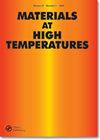Haynes 282微管在CO2中的高温氧化
IF 0.9
4区 材料科学
Q4 MATERIALS SCIENCE, MULTIDISCIPLINARY
引用次数: 1
摘要
本文报道了直径为1mm、厚度为200µm的Haynes 282微管在高温下暴露于CO2中的氧化特性。在700°C和1atm下加热215小时后,一层薄薄的保护性铬垢从外表面累积到2.03µm,约为厚度的1%,并且在2.59µm处观察到内部铝氧化。结果表明,氧化受到氧通过氧化垢层扩散的限制。微管的平均晶粒尺寸为10µm,靠近内表面的晶粒尺寸减小到5µm。在整个微管中观察到严重的塑性变形和可变的动态恢复和再结晶。尽管发生了再结晶,但微管中的总体晶粒尺寸和分布与热暴露无关。高温合金微管几何结构在高温热应用中表现出良好的性能。本文章由计算机程序翻译,如有差异,请以英文原文为准。
High-temperature oxidation of Haynes 282 microtubes in CO2
ABSTRACT The oxidation characteristics of Haynes 282 microtubes measuring 1 mm in diameter and 200 µm thick exposed to CO2 at elevated temperature are reported. After 215 hours at 700°C and 1 atm, a thin, protective chromia scale accumulates up to 2.03 µm from the outer surface, approximately 1% of the thickness, and internal aluminum oxidation is observed 2.59 µm from the inner surface. The results suggest that oxidation is limited by oxygen diffusion through the growing oxide scale layer. The average grain size in the microtube is 10 µm, and it decreases to 5 µm closer to the inner surface. Severe plastic deformation and variable dynamic recovery and recrystallization from the manufacturing process were observed throughout the microtube. Overall grain size and distribution in the microtube were found to be independent of thermal exposure, despite the occurrence of recrystallization. The superalloy microtube geometry shows promising performance in high-temperature thermal applications.
求助全文
通过发布文献求助,成功后即可免费获取论文全文。
去求助
来源期刊

Materials at High Temperatures
工程技术-材料科学:综合
CiteScore
1.90
自引率
15.40%
发文量
58
审稿时长
>12 weeks
期刊介绍:
Materials at High Temperatures welcomes contributions relating to high temperature applications in the energy generation, aerospace, chemical and process industries. The effects of high temperatures and extreme environments on the corrosion and oxidation, fatigue, creep, strength and wear of metallic alloys, ceramics, intermetallics, and refractory and composite materials relative to these industries are covered.
Papers on the modelling of behaviour and life prediction are also welcome, provided these are validated by experimental data and explicitly linked to actual or potential applications. Contributions addressing the needs of designers and engineers (e.g. standards and codes of practice) relative to the areas of interest of this journal also fall within the scope. The term ''high temperatures'' refers to the subsequent temperatures of application and not, for example, to those of processing itself.
Materials at High Temperatures publishes regular thematic issues on topics of current interest. Proposals for issues are welcomed; please contact one of the Editors with details.
 求助内容:
求助内容: 应助结果提醒方式:
应助结果提醒方式:


